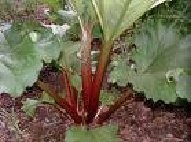|
Rhubarb Root -- Delicious Pies & So Much MoreThe following information is directly quoted from the LINK BELOW. It is meant to be educational only...... this herb is an important ingredient in the cleansing herbs for the MOST IMPORTANT equine colic cure that I have used with 99.9999% success since 1977. It is considered a wonderful cleanser for the intestines, bowels, liver and blood, helping to rid the system of accumulated toxins. It is also an antimicrobial, antibacterial, antibiotic and antiviral, and it may even help to improve your digestion. Botanical: Rheum officinale Family: Polygonaceae (buckwheat) Rheum palmatum is commonly known as Chinese rhubarb, and Rheum rhabarbarum (also known as R. rhaponticum) is commonly referred to as wild rhubarb in the U.S. Both plants belong to the family Polygonaceae. Rhubarb has very broad leaves and elongated, often reddish, petioles (leaf stalks). 
History: Rhubarb Root is a leafy, hardy perennial that is one of many species native to the cool mountains and high plateaus of western and northwestern China, India, Tibet, Russia and Turkey, that have been used in Asia for their laxative properties as far back as the Han Dynasty (206 B.C.- A.D.23). It occurs in commerce under various names (Russian, Turkey, East Indian and Chinese), but the general geographical origin of all species is the same; the commercial names simply refer to the route by which the herb was formerly transported to European markets. The origin of the name of it's botanical genus, Rheum, is somewhat vague: Some believe that it is derived from the Latin words, Rha Babrum, an ancient name for the Volga River, where the plant grew in profusion; others claim that it comes to us from the Greek word, rheo, which means "to flow," an allusion to the root's purgative properties. Beneficial Uses: Rhubarb Root has been used for over two thousand years as a mild, yet powerful and effective, laxative that empties the intestines and cleanses the bowels thoroughly. The anthraquinone glycosides (also found in Senna, Buckthorn and Cascara Sagrada) are natural stimulants and produce a purging action, which make it useful for treating chronic constipation. At higher doses, the anthraquinone activity is throught to predominate, resulting in more watery and more frequent stools. Its mild action has been considered suitable for children, and it is often used to soften stool in the presence of anal fissures and hemorrhoids and used post-operatively for recto-anal operations. In China, it is included in some standard bowel preparation programs for colonoscopy. It's tannins produce astringent properties, and when taken in small doses, the tannin activity in it supersedes the anthraquinone activity, thus leading to a lower water content of stool, and this action has been effective in relieving diarrhea. Moreover, the pectin it contains is also thought to work well with tannins as an anti-diarrheal. As an effective astringent, it has been used to alleviate hemorrhoids, internal bleeding and inflamed mucous membranes. Rhubarb Root is considered an "alterative" or agent that helps to gradually and favorably alter the course of an ailment or condition. It helps to modify the process of nutrition and excretion and restore normal bodily function, acting to cleanse and stimulate the efficient removal of waste products from the system. As such, it not only cleanses the intestinal tract and blood, but it is also thought to cleanse the liver by encouraging bile flow. The herb is said to enhance gallbladder function and relieve both liver and gallbladder complaints by releasing an accumulation of toxins. The bitter principle included in Rhubarb Root is said to stimulate good digestion and improve the appetite. It is considered a "stomachic" that relieves gastric disorders, improves the appetite and gives tone and strength to the stomach. Rhubarb Root is thought to be particularly effective in treating atonic dyspepsia, helping the digestive organs when in a condition of torpor and debility. In addition, the herb is also believed to encourage gastric flow, which also aids the digestive process. Rhubarb Root is considered an anti-microbial that has been used to treat internal pinworms, threadworms and ringworms. Rhubarb Root has been used to relieve menstrual problems. The herb stimulates the uterus and is thought to move stagnated blood, which also helps to relieve pains and cramps. A special extract of Rhubarb (Rheum rhaponticum) has been used for many years to treat menopausal symptoms in Germany and elsewhere, and according to researchers, Rhubarb significantly reduced the frequency and severity of hot flashes in perimenopausal women. Until recently, hormone replacement therapy (HRT) was the most common treatment for menopausal hot flashes, but in the wake of negative side effects, there is much interest in finding safe, alternative treatments for hot flashes and other symptoms caused by menopause, and Rhubarb extract may be a viable alternative treatment for women experiencing severe hot flashes associated with menopause and perimenopause. Rhubarb Root is thought to possess antibacterial, antibiotic and antiviral properties. In modern medicine, Rhubarb Root has been found to be useful in treatment of hepatitis-B virus. In vitro studies, the anthraquinones in Rhubarb exhibited virucidal activity against HSV I, measles, polio and influenza virus; and the rhein component showed antibacterial activity against Bacteroides fragilis, but thus far, no conclusions have yet been published. Teas made from Rhubarb have been said to help relieve infection caused by bacteria. Rhubarb Root may be used externally to fight inflammation and infection (skin eruptions, boils and carbuncles, etc.) and to promote healing (wounds, cold sores and burns, etc.). |





